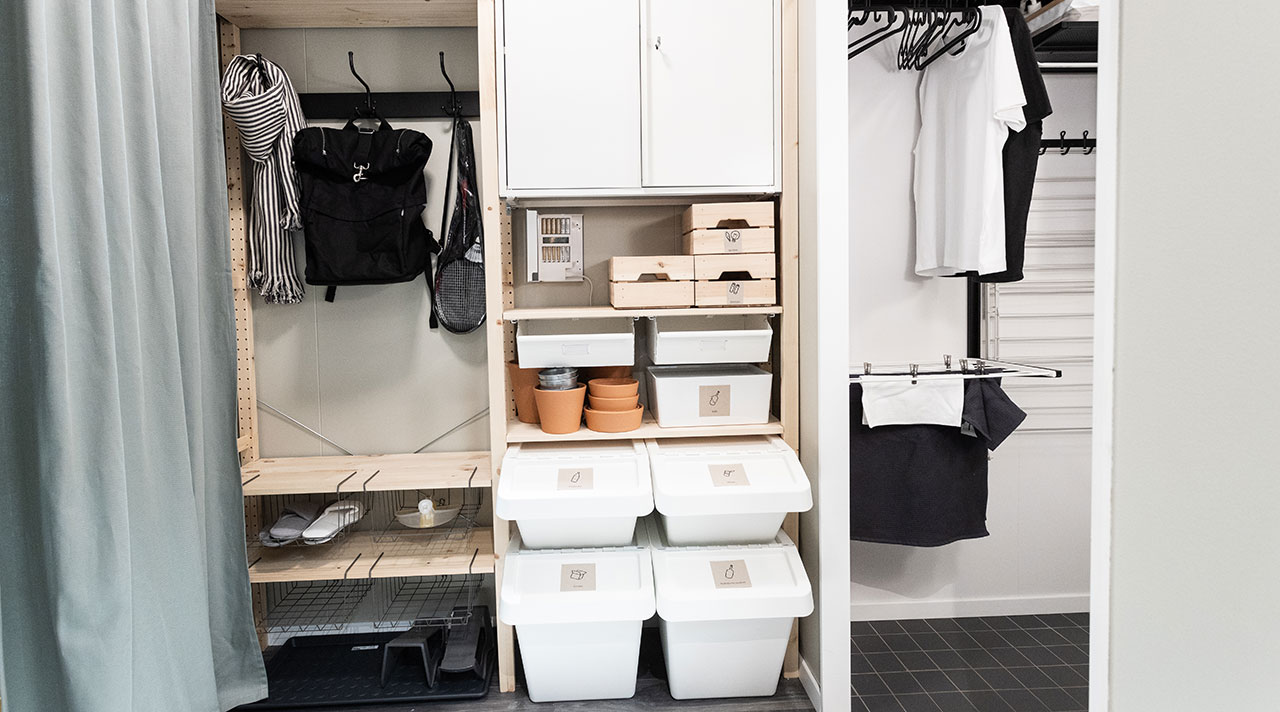
The entrance area is the first and the last space we see in our home – it greets us as we enter and says goodbye when we leave. A harmonious interior helps to relax when stepping into home, but how can the entrance area contribute to the overall sustainability in your home? It is a great not only for storage but also for waste sorting systems. With several containers, you can create your own individual sorting system depending on the sorting rules in your country. A smart idea for homes with small kitchen and for more motivation to remember to bring the waste out!
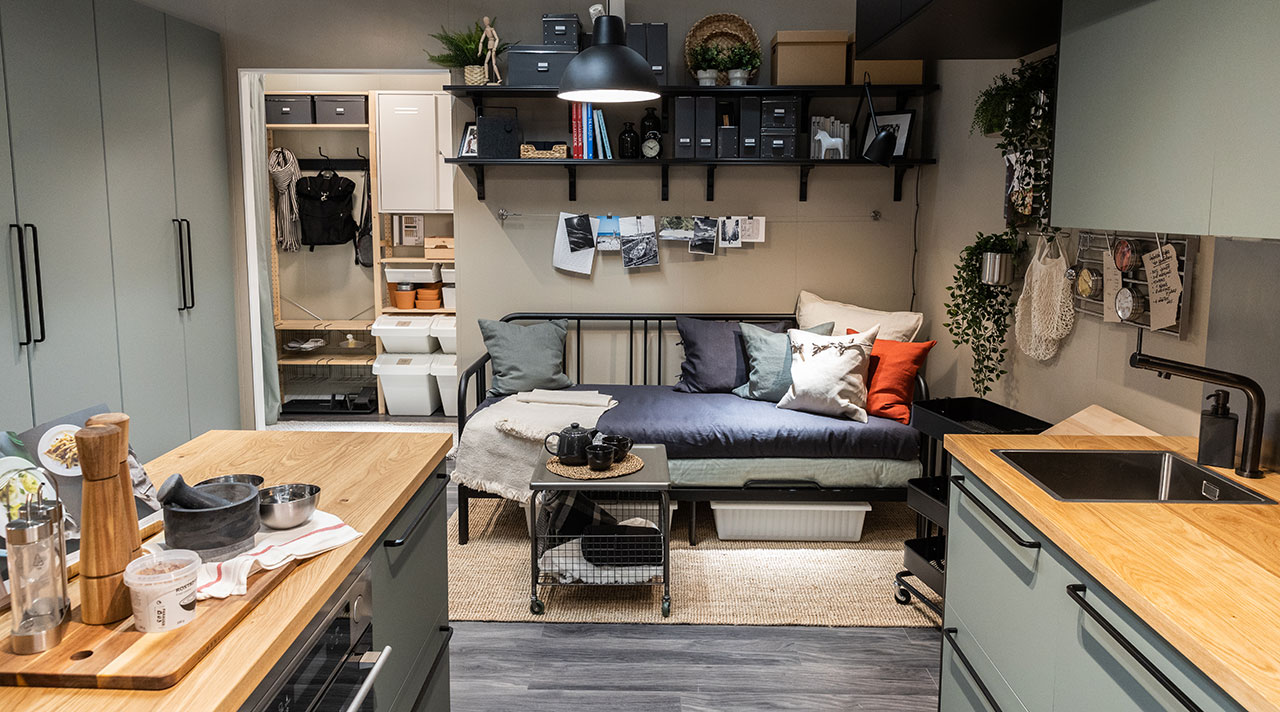
Small and efficient
The smaller the space, the more sophisticated the interior. Even those with a special place in heart for spacious rooms would admit that small homes are more energy efficient and that they do not seem cramped if the interior is done just right. Use the whole height of the walls for storage and keep the colour scheme simple for a more spacious impression. For more sustainable solutions, use natural materials, LED lighting and other features that are not just nice to have but also support a better future for our planet.
The smaller the space, the more sophisticated the interior. Even those with a special place in heart for spacious rooms would admit that small homes are more energy efficient and that they do not seem cramped if the interior is done just right. Use the whole height of the walls for storage and keep the colour scheme simple for a more spacious impression. For more sustainable solutions, use natural materials, LED lighting and other features that are not just nice to have but also support a better future for our planet.
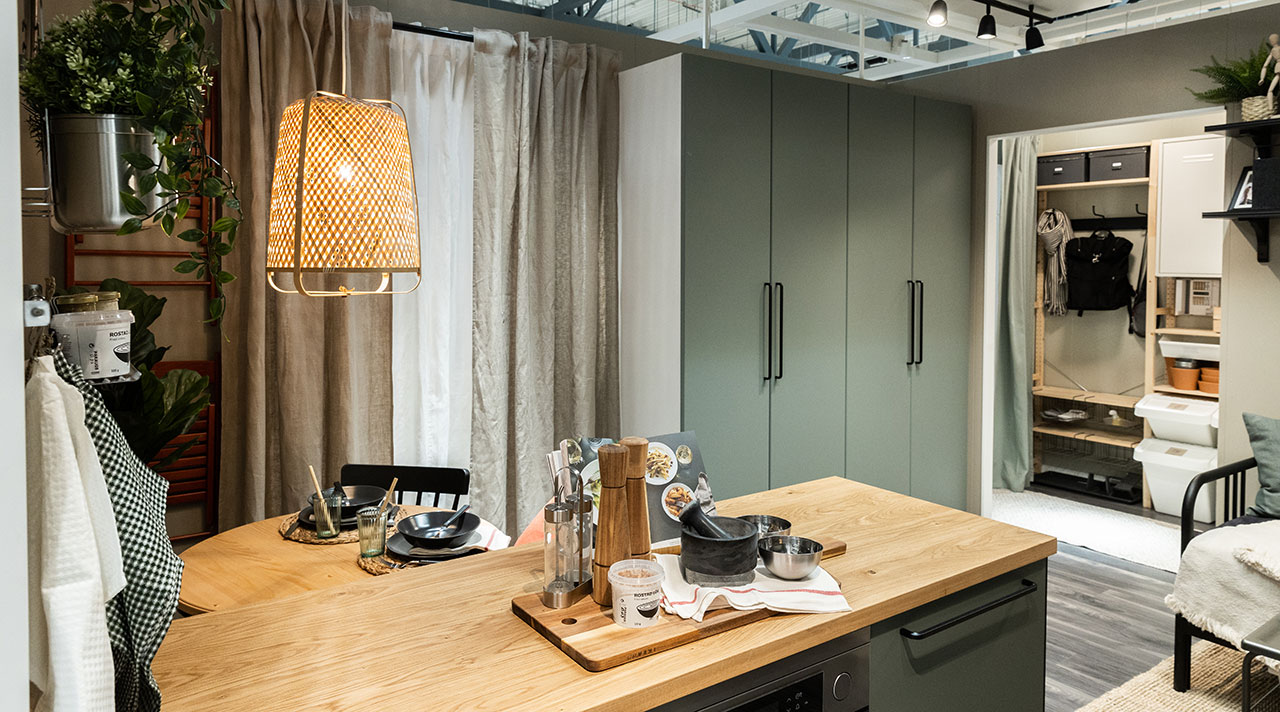
Textiles in a sustainable home
In colder climates, heating is always an issue, as it tends to quite expensive and many solutions for heating systems are not what we would call environmentally friendly. A way of reducing the energy consumption is using interior textiles. For example, a carpet absorbs heat and keeps off the cold coming from the floor, but curtains can be opened during the day to let the sun in and closed during the dark time of the day to keep the warmth in, as windows are the one place in room, where the most heat is lost.
In colder climates, heating is always an issue, as it tends to quite expensive and many solutions for heating systems are not what we would call environmentally friendly. A way of reducing the energy consumption is using interior textiles. For example, a carpet absorbs heat and keeps off the cold coming from the floor, but curtains can be opened during the day to let the sun in and closed during the dark time of the day to keep the warmth in, as windows are the one place in room, where the most heat is lost.
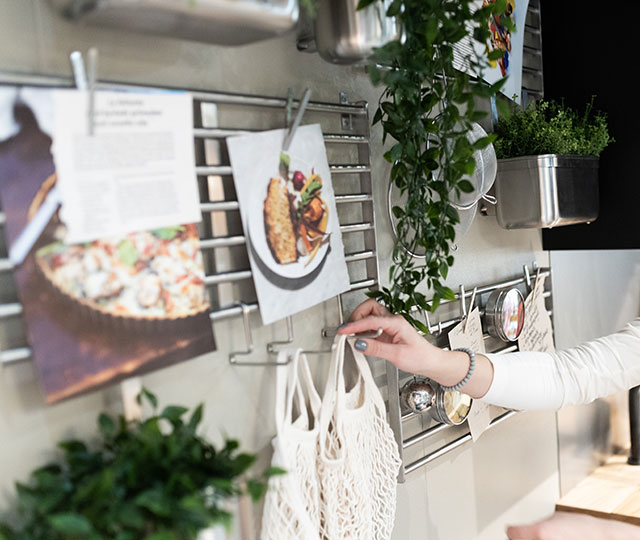
Take control of your everyday
Kitchen is the perfect place to create a command centre. You can use it for collecting some recipes that can come in handy when preparing shopping lists so you do not end up with products that later land in waste. Here, you can also keep some fabric shopping bags to take with you when going to the grocery store. Fabric bags are sturdy, can be folded very small and put in a bag and contribute to reducing plastic waste.
For tasty and healthy meals, you can grow your own greens right in the kitchen. Line them up along the wall and just take some when your food needs that little extra. Every green plant in your home helps to purify the air you breathe and makes the home environment much better.
Kitchen is the perfect place to create a command centre. You can use it for collecting some recipes that can come in handy when preparing shopping lists so you do not end up with products that later land in waste. Here, you can also keep some fabric shopping bags to take with you when going to the grocery store. Fabric bags are sturdy, can be folded very small and put in a bag and contribute to reducing plastic waste.
For tasty and healthy meals, you can grow your own greens right in the kitchen. Line them up along the wall and just take some when your food needs that little extra. Every green plant in your home helps to purify the air you breathe and makes the home environment much better.

Every drop counts
If asked where the most water is consumed at home, most people would probably say bath. But think twice – almost every time you go into kitchen, you open the tap for some or other reason. Knowing that, it is just as good that all IKEA taps have an aerator – a smart device that helps to save up to 30 % of the water without losing any of the pressure. Another way of saving water in the kitchen is washing fruit and vegetables in a bowl or a half filled sink, not under running water. The same goes for washing up, although the more sustainable option is a dishwasher that uses less water for dishes than the traditional method of washing them by hand.
If asked where the most water is consumed at home, most people would probably say bath. But think twice – almost every time you go into kitchen, you open the tap for some or other reason. Knowing that, it is just as good that all IKEA taps have an aerator – a smart device that helps to save up to 30 % of the water without losing any of the pressure. Another way of saving water in the kitchen is washing fruit and vegetables in a bowl or a half filled sink, not under running water. The same goes for washing up, although the more sustainable option is a dishwasher that uses less water for dishes than the traditional method of washing them by hand.

When planning is everything
In kitchen, good planning is essential. Working is more efficient if the space is planned with ergonomics in mind and waste sorting comes natural if there is a comfortable system for that.
In kitchen, good planning is essential. Working is more efficient if the space is planned with ergonomics in mind and waste sorting comes natural if there is a comfortable system for that.
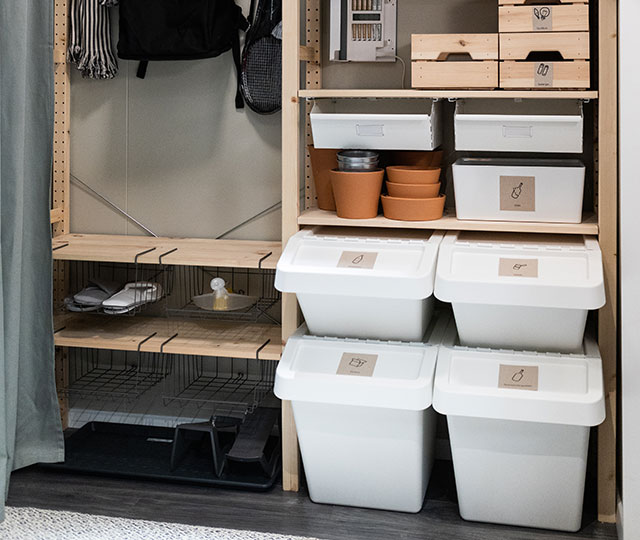
The right place for each and every thing
Organising is a key to harmony. If everything has a place then you do not waste time searching for things (often in vain!) and save yourself a lot of frustration! The hallway is great for some waste sorting solutions as well as for keeping some jars and fabric bags to take with you when planning to do some grocery shopping.
Organising is a key to harmony. If everything has a place then you do not waste time searching for things (often in vain!) and save yourself a lot of frustration! The hallway is great for some waste sorting solutions as well as for keeping some jars and fabric bags to take with you when planning to do some grocery shopping.
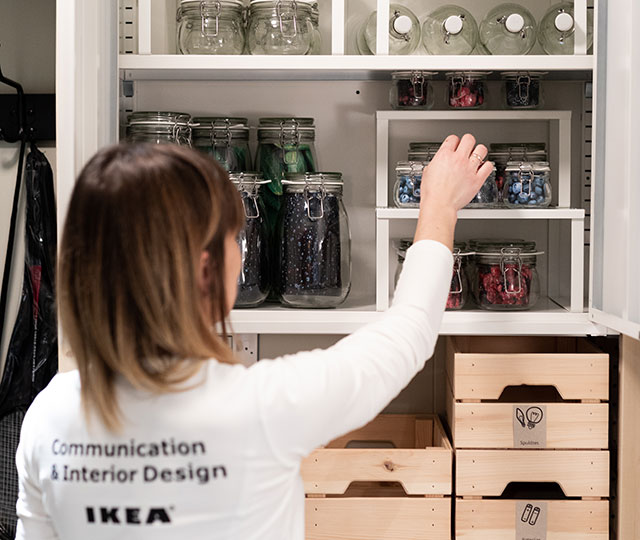
Better storage for less waste
Isn't it satisfying to look at an orderly storage? It sure is! Even better – better organisation helps to reduce food waste as everything is visible at a glance. We tend to eat what we see so it is a good idea to keep dry foods in glass jars and clear containers. For example, the KORKEN series is a great way of creating some great pantry solutions and it is made of 40 % recycled glass too! A rubber sealing helps to lock all the goodness in so the food stays fresh for longer.
Isn't it satisfying to look at an orderly storage? It sure is! Even better – better organisation helps to reduce food waste as everything is visible at a glance. We tend to eat what we see so it is a good idea to keep dry foods in glass jars and clear containers. For example, the KORKEN series is a great way of creating some great pantry solutions and it is made of 40 % recycled glass too! A rubber sealing helps to lock all the goodness in so the food stays fresh for longer.
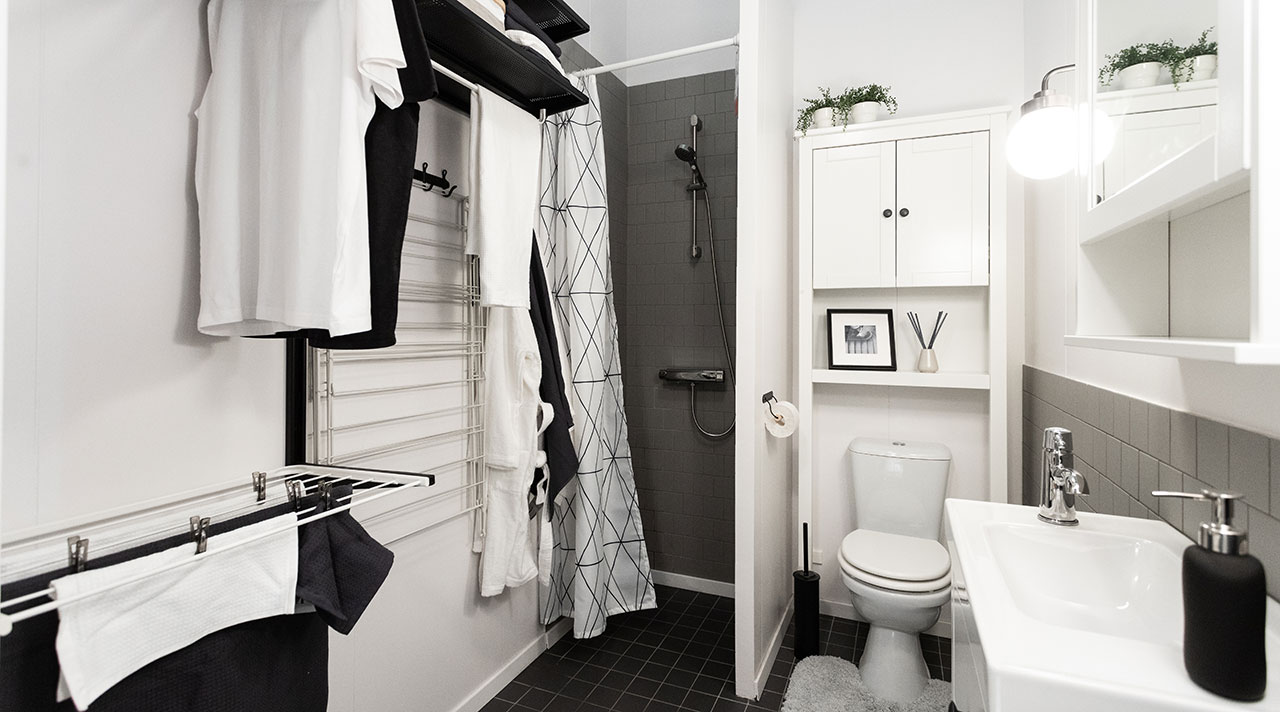
In search for simplicity
Did you know that IKEA offers water saving bathroom taps too? The included aerators help to reduce the water consumption for a more sustainable life at home.
A clothes dryer is another way of a more sustainable living. Letting the clothes dry in the air instead of putting them in an automatic dryer is great both for the environment and for your wallet as you save electricity.
Did you know that IKEA offers water saving bathroom taps too? The included aerators help to reduce the water consumption for a more sustainable life at home.
A clothes dryer is another way of a more sustainable living. Letting the clothes dry in the air instead of putting them in an automatic dryer is great both for the environment and for your wallet as you save electricity.
IKEA Family price
IKEA Family price













































































